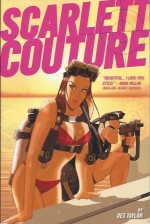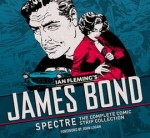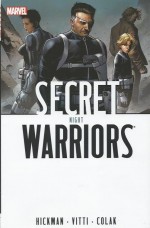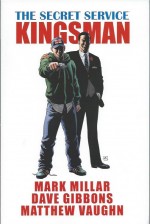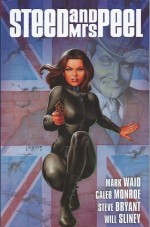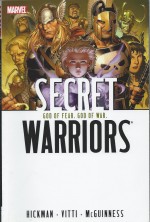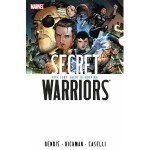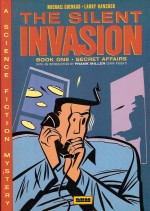
By Michael Cherkas & Larry Hancock (NBM)
ISBN: 978-0-91834-850-0
The 1980s were an immensely fertile time for English-language comics-creators. In America a fresh wave of creativity had started with the birth of dedicated comics shops and, as innovation-geared specialist retailers sprung up all over the country, operated by fans for fans, new publishers began to experiment with format and content, whilst eager readers celebrated the happy coincidence that everybody seemed to have a bit of extra cash to play with.
Consequently those new publishers were soon aggressively competing for the attention and cash of punters who had grown resigned to getting their on-going picture stories from DC, Marvel, Archie and/or Harvey Comics. European and Japanese material began creeping in and by 1983 a host of young companies such as WaRP Graphics, Pacific, Eclipse, Capital, Now, Comico, Dark Horse, First and many others had established themselves and were making impressive inroads.
New talent, established stars and fresh ideas all found a thriving forum to try something a little different both in terms of content and format. Even shoestring companies and foreign outfits had a fair shot at the big time and a much great material came – and, almost universally, just as quickly went – without getting the attention or success they warranted.
By avoiding the traditional family sales points such as newsstands, more mature material could be produced: not just increasingly violent and with nudity but also far more political and intellectually challenging too.
Moreover, much of the “brain-rotting trash†or “silly kid’s stuff†stigma had finally dissipated and America was catching up to the rest of the world in acknowledging sequential narrative as a for-real, actual Art-Form, so the door was wide open for gosh-darned foreigners to make a few waves too…
One of the most critically acclaimed and just plain fun features came from semi-Canadian outfit Renegade Press which, spun out by a torturous and litigious process from Dave Sim’s Canadian Aardvark-Vanaheim enterprise, set up shop in the USA and began publishing at the very start of the black and white comics bubble in 1984. Renegade quickly established a reputation for excellence, picking up a surprisingly strong line of creator-based properties and some genuinely remarkable and impressive series such as Ms. Tree, Journey: The Adventures of Wolverine MacAlistaire, Normalman, Flaming Carrot, the first iteration of Al Davison’s stunning Spiral Cage and compulsive, stylish Cold War, flying-saucer paranoia-driven series The Silent Invasion amongst others.
That last was a stunningly stylish saga, bolting 1950s homeland terrors (invasion by Reds; invasion by aliens; invasion by new ideas…) onto Film Noir chic and employing 20-20 hindsight to produce a truly fresh and enticing concept in the Reagan-era Eighties. I firmly believe that in this business nothing good stays lost, but now I’m fed up waiting for it to be rediscovered so I’m going to review my battered old copies as no one has tried to revive it yet. At least they’re still available…
This first superbly oversized monochrome tome – a whopping 298 x 2058 mm – gathers the lead story from the first three issues of The Silent Invasion with co-creators Michael Cherkas & Larry Hancock concocting a delightful confection combining all the coolest genre elements of classic sci-fi, horror, spy, conspiracy theory, crime, romance and even comedy yarns…
The 1950s in American were a hugely iconic and paradoxical time. Incredible scientific and cultural advancements and great wealth inexplicably arose amidst an atmosphere of immense social, cultural, racial, sexual and political repression with an increasingly paranoid populace seeing conspiracy and subversive attacks in every shadow and corner of the rest of the world.
Such an insular melting pot couldn’t help but be fertile soil for imaginative outsiders to craft truly incisive and evocative tales dripping with convoluted mystery and taut tension, especially when wedded to the nation’s fantastic – and then-ongoing – obsessions with rogue science, flying saucers, gangsterism and espionage…
They were also obsessed with hot babes and bust sizes, but more of that elsewhere…
Preceded by a terse and still topical Introduction from Frank Miller, this towering collection from 1988 kicks off with ‘Chapter One: Atomic Spies’ in a dark desert landscape 22 miles outside Union City in April 1952.
Private eye Dick Mallet sees a strange light in the skies and in the morning the cops find his crashed car. There’s no sign of the infamous and distinguished Dick…
A month later reporter Matt Sinkage is still unhappy with his piece on “The Truth Behind Flying Saucers†but his muttering and musing is interrupted by a hot blonde banging on the door of his foreign-sounding neighbour Ivan Kalashnikov.
Arriving at his desk on the Sentinel, Sinkage can’t believe the audacity of the Air Force’s official line about “marsh gas†and starts screaming at his Editor Frank Costello who just bawls him out – again – and sends him off to cover real news…
Instead Sinkage heads out to the site of the latest sighting and starts interviewing local yokels. That night fiancée Peggy cooks him a meal but his mind is elsewhere, on that night six months back in Albany when he saw a UFO and impetuously chased after it: a night everyone but him remembers…
Later, in a bar, Matt continues badgering Frank until the booze gets to him. Eventually Sinkage slinks back to his apartment. Ivan’s door is open and a quick glance reveals the foreigner and others in front of a huge, weird machine and Matt realises they must be Reds! Atomic spies!
Before the reporter can react, Kalashnikov pulls a really strange gun and shoots. Next morning Sinkage awakes with another sore head and fuzzy memory…
Days later Matt again collides with Mr K’s pretty friend Gloria Amber, but fails to get another look at his neighbour’s place. Undeterred, he resorts to asking her out to lunch and somehow provokes the old guy into taking a sudden trip out of town. Things get even stranger when Gloria comes running to him, being chased by what she claims are Red agents…
Spiriting her away, Matt doesn’t hear the pursuers accosting his landlord, claming to be Federal Men…
‘Chapter Two: Secrets and Insidious Machinations’ finds the fugitives deep in the suburbs with Matt’s sedate brother Walter. The reporter is still seeing flying saucers and can’t understand why everybody else thinks they’re just jets, whilst back in Union City Frank is getting a grilling from FBI Agent Housley.
They’re old acquaintances: the G Man regularly pops by to suppress one news item or another…
This time though they want the vanished Sinkage and are not happy that Costello has no idea of the gadfly’s current location. Back in suburbia, things are none too comfortable either. Stuck-up sister-in-law Katie is convinced Matt and his new floozy are up to no good and wants them out. At least she doesn’t know the FBI are scouring the city for them. Enigmatic Gloria, however, is more concerned that Sinkage is sleepwalking and having strange nightmares… just like Kalashnikov feared he might…
Matt and Gloria are just heading out in Walter’s borrowed car when Peggy pops by. She can’t understand why her man is with a flashy trollop and pointedly won’t talk to her. Gloria has told Matt the real Reds are after Kalashnikov’s memoirs and convinced him to drive her to a quiet town in the desert where a “contact†will protect them both. Mr K meanwhile has called in his own heavies to chase the couple, unaware that the FBI have visited Walter and Katie. A net is closing around Sinkage and the mystery woman he implicitly trusts… but really shouldn’t.…
The tension mounts in this volume’s concluding ‘Chapter Three: The Stubbinsville Connection’ as a mysterious Council of shadowy men gather to discuss the Sinkage problem. As Housley’s report continues, it become clear the reporter was also involved in the Albany event and near-panic ensues…
In a cheap motel Matt’s suspicions are back. Gloria vanished from their room for a while during the night and hasn’t mentioned it…
They’re confirmed a little later when she helps Kalashnikov’s hoods Zanini and Koldst abduct her and rough him up. Bach at Walter’s house the FBI turn up to interview them about Matt. They claim they’re the only Feds working on the case and no other government officials have been there before them…
Katie has had enough and spills all she knows. The agents instantly go into overdrive and organise all their forces to head for sleepy, remote Stubbinsville. Matt meanwhile has recovered and called the only guy he still trusts, his researcher Dan Maloney. That worthy warns him of the confusing profusion of agents all claiming to be working for the government, before sharing the same info with Frank Costello…
As Housley’s team fly in, Matt has decided to go on, hitchhiking to the rendezvous with a quirkily affable farmer who happily joins him in “pranking†the cops who have just arrested Zanini, Koldst and Gloria…
Reunited with his oddly-compliant mystery amour, Matt hurtles on to Stubbinsville in a stolen car but with less than 100 miles to go Gloria falls ill. She makes him promise to get her there at all costs…
As the assorted pursuers converge, she directs Matt to a lonely wilderness area, but the forces of law and order have spotted them and follow. As the net closes a fantastic and terrifying light show ignites the dark skies. By the time Housley reaches the specified target area, all he finds is a comatose Sinkage.
As days pass, Matt finds himself free with all charges dropped, but he’s oddly content. Despite another blatant cover-up and no clue as to who all the various parties hounding him actually were, he knows what he knows and wonders when Gloria will be back…
To Be Continued…
Potently evocative, impeccably unique and fabulously cool, The Silent Invasion is a boldly imagined and cunningly crafted adventure long-overdue for a modern revival: an unforgettable gateway to an eerily familiar yet comfortably exotic era of innocent joy and a million “top secrets†which no fan of fantastic thriller fiction should ignore.
© 1988 Michael Cherkas & Larry Hancock. Introduction © 1988 Frank Miller. All rights reserved.


